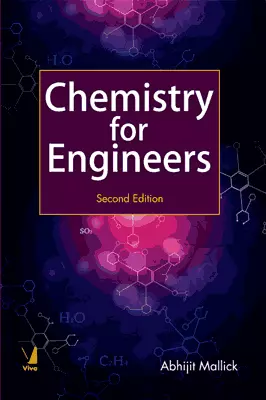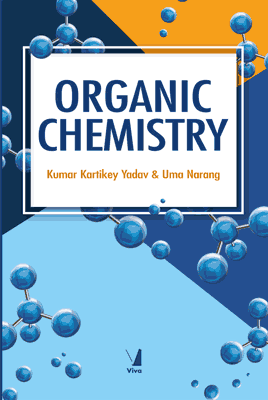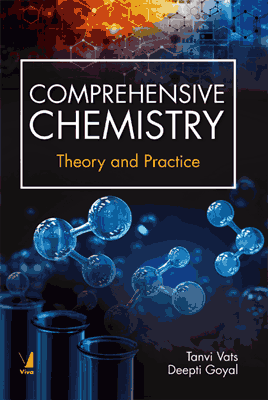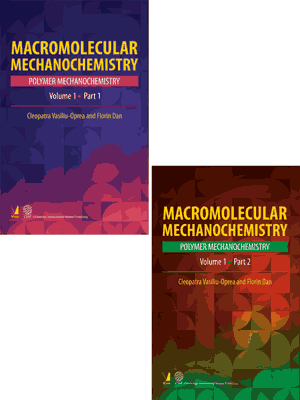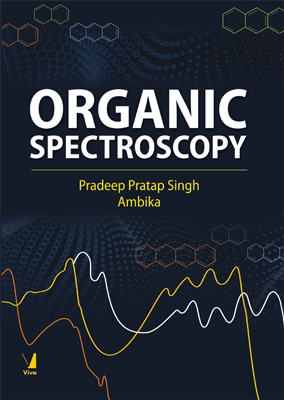Buy Chemistry Books for Engineering Online
Chemistry for Engineers, 2/e
₹715.50 ₹795.00 Save: ₹79.50 (10%)
Go to cartISBN: 9789389662139
Bind: Paperback
Year: 2020
Pages: 560
Size: 159 x 241 mm
Publisher: Viva Books Originals
Sales Territory: Worldwide
This book is especially designed for B.Tech. degree students following the guidelines of All India Council for Technical Education (AICTE) syllabus. This book is also useful for B.Sc. chemistry (honours) students. This second edition discusses in detail quantum chemistry and its important applications, MO concept and its applications, aromaticity, comprehensive discussion on UV spectroscopy, NMR spectroscopy as well as IR and microwave spectroscopy, stereochemistry and water chemistry. Besides these, real gas obeying van der Waals equation is also included in this edition. Detailed mathematical approach and well-illustrated figures are also given to understand the basic concept in a lucid manner. Exercises and numerical problems have also been included at the end of each chapter for practice. Appendix is also added which includes a collection of reference tables.
Target Audience:
This book is helpful for students and academicians of B.Sc. chemistry (honours) students along with B.Tech degree students following the guidelines of All India Council for Technical Education (AICTE) syllabus.
Contents:
Acknowledgements
Preamble
Chapter 1: Real Gases • Determination of Density of Vapour • Victor Meyer's Method • Density and Molecular Weight • Abnormal Density • PV-Isotherm of Ideal Gas • PV-Isotherm of Real Gas • Critical Point • Law of Rectilinear Diameter • Determination of Orthobaric Densities • Compressibility Factor • Van der Waals Equation • Reduced Equation of State • Boyle Temperature • Solved Problems • Exercises
Chapter 2: Quantum Chemistry • Atomic Structure • Bohr Theory of Atom • Radius of Hydrogen Atom • Energy of Bohr Orbit • Atomic Spectra • Limitations of Bohr's Theory • Heisenberg's Uncertainty Principle • De Broglie Concept • Wave Function • Eigenfunction and Eigenvalue • Properties of eigenfunction • Orthogonal Wave Functions • Physical significance • Operators • Time-dependent Schrödinger Wave Equation • Time-independent Schrödinger Wave Equation • Particle-in-a-box Solution • Calculation of A and Expression of ψ • Expression of Energy (E) and Momentum (p) • Significances of n • Nodes and Distribution Curves of Orbitals for Hydrogen Atom • The probability distribution curves • Shapes of different atomic orbitals • Wave function for different orbitals of H-atom • Hydrogen atom in ground state • Applications of Particle-in-a-1D-box Concept • Solved Problems • Exercises
Chapter 3: Molecular Orbital Theory • Concept of Molecular Orbital • LCAO Approach • General Rules for LCAO • LCAO – The Mathematical Approach • Overlapping of Atomic Orbitals • Gerade and Ungerade MO • Characteristic Features of MO Theory • Distinguish Between AO and MO • MO Diagrams of Different Diatomic Molecules • sp-Mixing • MO Diagrams of F2 and O2 Molecules • MO Diagram of N2 Molecule • MO Diagram of CO Molecule • MO Diagram of NO Molecule • MO Diagram of Cyanide Ion (CN –) • MO Diagrams of HF and HCl Molecules • Aromaticity of Organic Compounds • Aromatic Compounds: Criteria and Properties • Anti-aromatic Compounds: Criteria and Properties • Non-aromatic Compounds: Criteria and Properties • π-MO Diagram • Benzene molecule • Cyclopropenyl cation and anion • Cyclopentadienyl cation and anion • Metallic Bond • Characteristics of Metals • MO Theory to Explain Metallic Bond Formation • Solved Problems • Exercises
Chapter 4: Chemical Bonding • Atomic Spectra • Filling up of Atomic Orbitals by Electrons • Pauli's Exclusion Principle • Hund's Rule of Maximum Multiplicity • Aufbau Principle • Overlapping of Atomic Orbitals • Characteristic Features of Valence Bond Theory • Periodic Table • Periodicity of Properties • Ionisation potential • Electron affinity • Electronegativity • Atomic radius • Shielding or screening effect • Slater's rule • Inert pair effect • Polarisability and Dipole Moment • Chemical Bond • Ionic Bond • Characteristic features of ionic bonding • Molar lattice energy • Covalent Bond • Characteristic features of covalent bonding • Coordinate or Dative Bond • Hydrogen Bond • Characteristic features of hydrogen bond • Van der Waals Type of Bond • Characteristic features of Van der Waals type of bond • Metallic Bond • Merits and demerits of free electron theory • Hybridization • Hybridization: The Pictorial Concept • Characteristic Features of Hybridization • Spatial Configuration at Different States of Hybridization • VSEPR Theory • Postulates of VSEPR theory • Limitations • Solved Problems • Exercises
Chapter 5: Coordination Chemistry • Werner's Theory • Postulates of Werner's Theory • Limitations of Werner's Theory • Sidgwick's Proposition • Ligand and its Classification • Classification of Ligands • On the basis of species • On the basis of coordinate bonds • On the basis of coordination power • Isomerism in Coordination Compounds • Structural Isomerism • Ionisation isomerism • Linkage isomerism • Coordination isomerism • Polymerisation isomerism • Stereoisomerism • Nomenclature of Coordination Compounds • Chelates and Inner Metallic Complexes • Inner Metallic Complex or Inner Complex • First order inner complex • Second order inner complex • Third order inner complex • Theory Behind Complex Formation • Postulates of VB Model • Limitations of VB model • CFT and LFT Models • Postulates of CFT model • Postulates of LFT model • Characteristic features of LFT model • Crystal field stabilization energy (CFSE) • Jahn-Teller Distortion and Square Planar Complex • Square Planar Complex • Magnetic Behaviour • p-Acid Ligand • Factors Influencing Complex Formation • Solved Problems • Exercises
Chapter 6: Solid State Chemistry • Crystallography • Unit Cell • Atomic Radius • Effective Number of Atoms • Atomic Packing Factor (APF) • c/a Ratio in HCP Crystal • Density of a Cubic Crystal • Fundamental Laws of Crystallography • Miller Indices and Interplanar Spacing • Interplanar Spacing • Miller Indices for HCP Crystals • Bragg's Law • Band Theory of Solids • Brillouin Zones • Conclusions • Conductors, Semiconductors and Insulators • Intrinsic Semiconductors • Characteristic features of intrinsic semiconductors • Drift velocity and mobility • Law of mass action • Effect of temperature on conductivity of an intrinsic semiconductor • Conduction Mechanism in an Extrinsic Semiconductor • Effect of temperature on conductivity of an extrinsic semiconductor • Compound Semiconductor • Exercises
Chapter 7: Thermodynamics • Introduction • Thermodynamics • Classification of Thermodynamic Processes • Reversible process • Irreversible process • Zeroth Law of Thermodynamics • State Function • First Law of Thermodynamics • Internal Energy (U) • Physical Signficance of Internal Energy • Absolute Value of Internal Energy • Enthalpy (H) • Relation Between H and q for an Ideal Gas • Relation Between H and U for an Ideal Gas • Conclusions of First Law of Thermodynamics • Corollaries of First Law of Thermodynamics • Advantages of First Law of Thermodynamics • Limitations of First Law of Thermodynamics • Work • Expansion Work • Elementary Useful Work • Specific Heat • P-V-T Relations in Adiabatic Process • Ideal Gas • Calculation of Work • Reversible and Irreversible Processes • Heat Engine and Entropy • Process Description • Calculation of Total Work and Efficiency • Carnot's Theorem • Entropy – A State Function • Physical Significance of Entropy (S) • Second Law of Thermodynamics • Thermodynamic Temperature Scale • Calculation of Entropy • Ideal Gas • Entropy Change due to Phase Transition • Transition of One Mole of a Supercooled Liquid • Water at (–tºC) into Ice at (–tºC) • Entropy Change due to Mixing of Ideal Gases • Other State Functions • Helmholtz Free Energy or Work Function (A) • Gibbs Free Energy (G) • Physical significance of (ΔG)P,T < 0 • Conditions of equilibrium and spontaneous processes • Conditions of spontaneity for different chemical reactions • Gibbs Helmholtz Equations • Gibbs Helmholtz Equation in Terms of Work Function, A • Gibbs Helmholtz Equation in Terms of Gibbs Free Energy, G • Maxwell's Relations • Partial Molar Quantities and Gibbs-Duhem Equation • Partial Molar Quantities and Chemical Potential • Gibbs-Duhem Equation • Chemical Potential of Components • Ideal Gas Mixture and Ideal Solution • Van’t Hoff Equation • Equilibrium Constant (Ka) and Standard Free • Energy Change (ΔG0) • Temperature Dependence of the Equilibrium Constant (Ka) • Ellingham Diagram • Introduction • Properties of the Ellingham Diagram • Limitations • Applications • Solved Problems • Exercises
Chapter 8: Electrochemical Cell • Electrolysis • Conductor • Faraday's Laws • Electrochemical Equivalent (ECE) • Electrolytic Conductance of Electrolytes • Electrolytic Conductivity • Equivalent Conductivity • Molar Conductivity • Mobility • Mathematical Expression • Mobility of Hydroxonium (H3O+) and Hydroxyl (OH–) Ions • Electrochemical Cells and Electromotive Force • Electrochemical Cell • Thermodynamics of Electrochemical Cells • Significance of Temperature Coefficient of the Cell • Nernst Equation for Single Electrode Potential and Electrochemical Cell • Nernst Equation for a Cell • Classification of Electrodes • First Kind of Electrode • Second Kind of Electrode • Third Kind of Electrode • Reference Electrodes • The Hydrogen Electrode • Preparation of hydrogen electrode • Calomel Electrode • Silver-Silver Chloride Electrode • Applications of Single Electrode Potential • Determination of pH of an Unknown Solution • Determination of pH by SHE • Determination of pH using quinhydrone electrode • Determination of pH using glass electrode • Determination of Solubility Product of a Sparingly Soluble Salt • Determination of Ionic Product of Water • Determination of Equilibrium Constant • Potentiometric Titration • Selection of indicator electrode • Calculation of equivalence potential, Ep, of a redox reaction • Concentration Cells • Applications • Determination of transport number • Determination of valency of an ion • Accumulators • Lead-Acid Accumulator • Nickel-Cadmium Alkaline Accumulator • Zinc-Silver Alkaline Accumulator • Fuel Cell • Working Principle • Types of Fuel Cells • Acid and alkaline fuel cell • Molten carbonate fuel cell • Direct methanol fuel cell • Solid oxide fuel cell (SOFC) • Proton exchange membrane fuel cell (PEMFC) • Zinc-air fuel cell • Regenerative fuel cell • EMF and Efficiency of a Fuel Cell • Choice of Fuel • Advantages, Limitations and Applications • Solved Problems • Exercises
Chapter 9: UV Spectroscopy • Electromagnetic Spectrum • Sources of UV Radiation • Electron Spin State • Types of Transitions • Franck-Condon Principle • Selection Rules • Lambert-Beer's Law • Limitations of Lambert-Beer's Law • UV Spectra and Shift • Chromophores and Auxochromes • Types of Shifts in UV Spectra • Factors Influencing ?max in UV Spectra • Solvent • pH • Conjugated System • Temperature • Nature of Substituent • Steric Effect • Applications of UV Spectroscopy • Fluorescence and Phosphorescence • Some Examples of Fluorophores • Applications of Fluorescence • Woodward-Fieser Rule • Rule • Types of conjugated dienes • Types of double bonds • Conjugated Diene System (λmax Value) • α, β-Unsaturated Ketone (λmax Value) • Aromatic Keto Compounds • Solved Problems • Exercises
Chapter 10: Microwave and IR Spectroscopy • Microwave Spectroscopy • Bond Length and Reduced Mass • Rotational Energy • Population of Energy Levels • Boltzmann distribution function • Degeneracy of energy levels • Selection Rules • Characteristics of Microwave Spectroscopy • Microwave Spectrum • P-branch and R-branch of rotational spectra • Applications of Microwave Spectroscopy • Vibrational Spectroscopy • Introduction • Potential Energy Curves and Energy Levels • Selection Rules • Characteristics of IR Spectroscopy • Applications of IR Spectroscopy • Solved Problems • Exercises
Chapter 11: NMR Spectroscopy • Definition of NMR • Theory • Nuclear Magnetic Resonance Spectrometer • Conditions to get Resonance Signal • Chemical Shift • Shielding and Deshielding • Factors Influencing d • Applied magnetic field • Inductive effect • Resonance effect • Hydrogen bonding • Van der Waals deshielding effect • Temperature • Purity of the sample • Solvent • Anisotropy effect • HNMR Shift Data • Information Based on NMR Spectrum • Applications of NMR • Solved Problems • Exercises
Chapter 12: Organic Chemistry • Introduction • Classification • Aliphatic compounds • Aromatic compounds • Functional groups • Reaction Mechanism • Controlling Factors • Inductive Effect • Electromeric Effect • Positive electromeric effect (+E effect) • Negative electromeric effect (–E effect) • Resonance Effect • Characteristic features • +R (+M effect) • –R (–M effect) • Hyperconjugative Effect (Baker-Nathan Effect) • Characteristic features of hyperconjugative effect • Hybridization • Steric Factor • Nucleophiles and Bases • Nucleophiles • Bases • Classification of Organic Reactions • Substitution Reactions • Free-radical substitution • Electrophilic substitution (SE) reactions • Nucleophilic substitution (SN) reactions • SN1 mechanism • SN2 mechanism • SNi mechanism • Elimination Reactions • E1 mechanism • E2 mechanism • Saytzeff rule versus Hofmann rule • Elimination and Substitution – Differences • Addition Reactions • Characteristic features • Electrophilic addition to conjugated diene • Nucleophilic addition reaction • Aromatic Substitution Reactions • Nitration of Benzene • Sulphonation of Benzene • Alkylation of Benzene (Friedel-Crafts Reaction) • Halogenation of Benzene • Disubstitution in Benzene Ring • Activation of aromatic rings • Inductive activation • Resonance activation • Deactivation of aromatic rings • Inductive deactivation • Resonance deactivation • Orientation in Disubstituted Benzene Ring • Some Rearrangement Reactions with Mechanisms • Beckmann Rearrangement (1886) • Hofmann Reaction • Cannizzaro Reaction • Intramolecular Cannizzaro reaction • Aldol condensation • Halogenation of Ketones • Acid catalyzed halogenation • Base catalyzed halogenation • Diels-Alder Reaction • Ionic mechanism • Free radical mechanism • One-step concerted mechanism • Reimer-Tiemann Reaction • Skraup Synthesis • Solved Problems • Exercises
Chapter 13: Stereochemistry: A Basic Concept • Optical Isomers • The Molecule has Asymmetric Carbon Atom but does not Possess any Symmetry • The Molecule has Asymmetric Carbon Atom and One Plane of Symmetry • Structural (Constitutional) Isomers • Conformational Isomers • Configurational Isomers (Stereoisomers) • Stereo and constitutional isomers • Distinguish between conformation and configuration • Priority Rule and CIP (Cahn-Ingold-Prelog) Sequence • Absolute Configuration • Priority Selection in R/S Configuration • Chirality • Achirality due to plane of symmetry • Achirality due to mirror images • Chirality due to steric hindrance • Conformers • Enantiomers • Properties of enantiomers • Diastereomers • Properties of diastereomers • Meso-compound • Properties of Isomers • Optical Rotation • Dextro/Laevo Nomenclature • Relative configuration • Fischer d- and l-projection nomenclature • Projections • Flying Wedge Projections • Sawhorse Projections • Newman Projections • Fischer Projections • Conversions from One Projection to Another • Conversion from Sawhorse Projection to Newman Projection • Conversion from Sawhorse Projection to Fischer Projection • Conversion from Newman Projection to Fischer Projection • Conversion from Fischer Projection to Sawhorse Projection • Conversion from Fischer Projection to Newman Projection • Conversion from Newman Projection to Sawhorse Projection • Conversion from Flying Wedge Projection to Fischer Projection • Conversion from Fischer Projection to Flying Wedge Projection • Conversion from Newman Projection to Flying Wedge Projection • Solved Problems • Exercises
Chapter 14: Corrosion • Definition • Classification • Chemical or Dry Corrosion • Oxidation corrosion • Corrosion by other gases, e.g. Cl2(g), H2S(g) • Liquid metal corrosion • Electrochemical Corrosion • Characteristic Features • Polarization of Electrodes • Rusting of Iron • Other Forms of Corrosion • Uniform Corrosion • Galvanic Corrosion • Passivity or passivation • Crevice Corrosion • Pitting Corrosion • Intergranular Corrosion • Other defects in welding • Selective Leaching • Erosion Corrosion • Stress Corrosion • Biocorrosion • Soil Corrosion • Stray Current Corrosion • Factors Influencing Corrosion • Nature of Metal • Nature of the Corroding Environment • Protective Measures Against Corrosion • Modification of the Environment • Modification of the Composition of Alloy • Effects of alloying elements on steel • Cathodic Protection • Hot dipping • Electroplating • Metal spraying • Metal cladding • Cementation • Use of Inhibitor • Use of Protective Coatings • Metal coatings • Inorganic coatings • Organic coatings • Solved Problems • Exercises
Chapter 15: Water Chemistry • Hardness of Water • Types of Hardness of Water • Temporary Hardness • Boiling method • Clark's method • Permanent Hardness • Unit of Hardness • Estimation of Hardness of Water Using Complexometric Titration • Theory • Procedure • Experimental Results and Calculations • Estimation of Permanent Hardness • Treatment of Hard Water • External Treatment • Lime-Soda process • Zeolite process or Permutit process • Demineralization or deionization process • Internal Treatment • Phosphate conditioning • Calgon conditioning • Alkalinity of Water • Problems on Boiler • Boiler Corrosion • Caustic Embrittlement • Scale and Sludge • Carry Over • Numerical Problems on Water Softening by Lime-Soda Process • Solved Problems • Exercises
Appendix
Bibliography
Index
The Periodic Table
About the Author:
Abhijit Mallick is an associate professor in the Department of Chemistry, Academy of Technology, affiliated to Maulana Abul Kalam Azad University (formerly known as West Bengal University of Technology). He completed his B.Sc. in chemistry honours from Ramakrishna Mission Vivekananda Centenary College, affiliated to the West Bengal State University (formerly affiliated to Calcutta University) and obtained his postgraduate degree from University College of Science and Technology, Calcutta University. He earned his Ph.D. from the Indian Institute of Technology, Kharagpur. He has published several international papers and four textbooks entitled, Chemistry for Engineers, Principles of Physical Metallurgy, Environmental Science and Management and Principles of Physical Chemistry. All four are published by Viva Books. He is a member of the Institution of Engineers (India). His areas of interest include applied chemistry, materials science, environmental pollution control and management.
